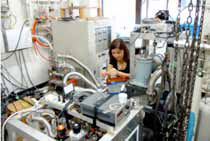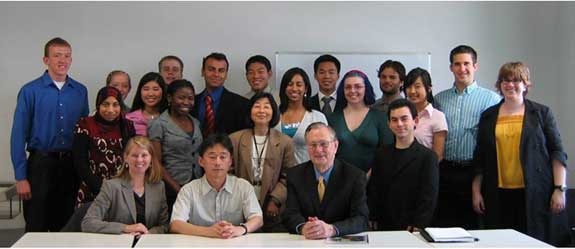NanoJapan: Connecting U.S. Undergraduates with the Best of Nanoscience Research in Japan
By Dr. Cheryl Matherly, University of Tulsa, Sarah Phillips, Rice University, and Prof. Junichiro Kono, Rice University

Jeffrey Lee at the Bunraku National Theater in Osaka, Japan
Jeffrey Lee, a sophomore majoring in mechanical engineering at Rice University, described the moment during the 2010 NanoJapan Program in which he really understood the global nature of science research. “The best example . . . came when a professor from Boston University came to [Professor Tonouchi’s] lab and gave a talk at an Osaka University symposium. Sometime that week, I found myself eating dinner with an American professor, a doctorate student from China, all hosted by a Japanese professor and his lab, and I realized truth behind the statement that science transcends international borders.”
Lee’s experience reinforced one of the learning objectives of the NanoJapan International Research Experience for Undergraduates. The NanoJapan International Research Experience for Undergraduates (IREU) program is the key educational initiative of the National Science Foundation funded Partnerships for International Research and Education (NSF-PIRE) grant awarded to Professor Junichiro Kono of Rice University and his collaborators at the University of Tulsa, University at Buffalo (SUNY), University of Florida, Texas A&M University, and Southern Illinois University, Carbondale. Initially just one of twelve projects selected for the PIRE program in 2006, the PIRE: U.S.-Japan Cooperative Research and Education on Terahertz Dynamics in Nanostructures renewal grant will support the expansion of a unique interdisciplinary U.S.-Japan research and education partnership focused on terahertz (THz) dynamics in nanostructures over the next five years. The U.S. and Japan are global leaders in both THz research and nanoscience, and stimulating cooperation is critical to further advance THz science and develop commercial products from new ideas in the lab. However, obstacles exist for international collaboration - primarily linguistic and cultural barriers - and this PIRE renewal project aims to continue to break down these barriers by providing future generations of researchers with a better understanding of both the culture and the state-of-the-art technology in each country.
The strong educational portfolio of this project focuses on cultivating interest in nanotechnology among young U.S. undergraduate students, especially those from underrepresented groups, and encouraging such students to pursue graduate study and academic research in the physical sciences. NanoJapan is a twelve-week summer program that involves first and second year undergraduate science and engineering students from U.S. universities in research internships with Japanese nanoscience laboratories. While the heart of the program is the summer research experience, NanoJapan places strong emphasis on preparing students to work effectively in cross-cultural laboratory settings. Before beginning work in their research labs, students complete a three-week orientation program based in Tokyo that combines 45 hours of Japanese language instruction, an orientation to Japanese life and culture, and an introduction to nanoscale science in Japan. At the completion of the orientation, the students depart for their research labs, working for eight weeks at universities throughout Japan – Hokkaido University, Tohoku University, the University of Tokyo, Chiba University, Tokyo Institute of Technology, Keio University, Shinshu University, Osaka University, and Osaka Institute of Technology. At the end of the summer, the students return to Rice University to participate in a re-entry seminar and present their summer research with other students who completed domestic research projects as part of the Rice Quantum Institute Annual Research Colloquium.

Aleksandra Simicevic (LA State University) working in the Nojiri Lab at Tohoku University
Each of the participating labs agreed to host a NanoJapan student to work on a research project under the supervision of a mentor, usually an English-speaking graduate student or post-doc. It is unusual for first and second year undergraduate students to conduct research in Japanese universities, yet the hosting professors report that the students contribute both to the research and the general “internationalization” of the lab. The Japanese graduate students must speak English with the U.S. students, providing them essential practice with the language necessary for their participation in the international science community. One hosting professor explained, “It is very important for Japanese young generation to work in an international environment. In this sense, it is highly beneficial for my students to work together with foreign students who are conducting activities across national boundaries. All the NanoJapan students in these three years we welcomed were excellent, well-educated, and active for scientific research. They provided very nice stimuli and atmosphere to our laboratory, leading to enhance research activities.”
As noted by Prof. Kono, "The status of the United States in science and engineering is changing. More and more people outside the U.S. are doing cutting-edge research. Graduate students today are more likely to succeed if they are prepared to work in a cross-cultural, multinational environment.” By involving and training students in cutting-edge research projects in nanoscale science and engineering, NanoJapan aims to increase the numbers of U.S. students who choose to pursue graduate study in this field while also cultivating a generation of globally aware engineers and scientists who are prepared for international research collaboration.

Former NSF Director Arden Bement meets with NanoJapan 2008 participants at the Tokyo Institute of Technology

To learn more about the NSF-PIRE TeraNano Center and NanoJapan program, see http://nanojapan.rice.edu. To learn more about the NSF Partnerships for International Research & Education (PIRE) program, see http://www.nsf.gov/funding/pgm_summ.jsp?pims_id=12819
Disclaimer- The articles and opinion pieces found in this issue of the APS Forum on Education Newsletter are not peer refereed and represent solely the views of the authors and not necessarily the views of the APS.
